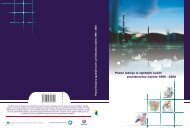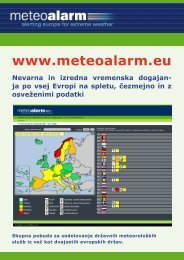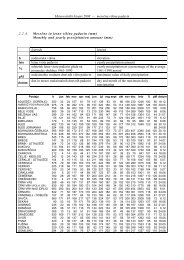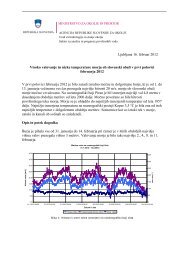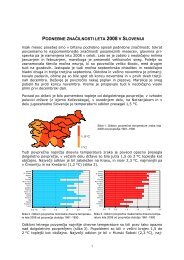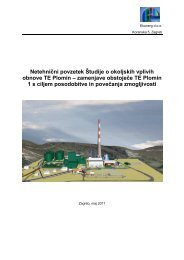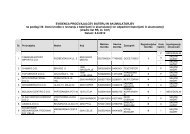Water Quality in Slovenia - Agencija RS za okolje
Water Quality in Slovenia - Agencija RS za okolje
Water Quality in Slovenia - Agencija RS za okolje
Create successful ePaper yourself
Turn your PDF publications into a flip-book with our unique Google optimized e-Paper software.
S U R F A C E W A T E R S<br />
Exceeded values of adsorbable organic halogen compounds (AOX) were measured <strong>in</strong> the water<br />
bodies <strong>in</strong>to which wastewaters with a large annual amount of AOX are discharged (23), or high<br />
concentrations are brought <strong>in</strong> by their tributaries (24). Despite the data on the reduction of AOX<br />
emissions <strong>in</strong>to waters <strong>in</strong> 2006 <strong>in</strong> relation to 2005 (24), an exceedance of the limit values was determ<strong>in</strong>ed<br />
<strong>in</strong> the Mura (Chart 1), the Ledava and the Logaščica.<br />
Chart 1: AOX concentrations <strong>in</strong> the Mura river <strong>in</strong> the years 2003 to 2006<br />
�������������<br />
��<br />
��<br />
��<br />
��<br />
��<br />
��<br />
��<br />
�<br />
����������<br />
�����������<br />
����������<br />
������������<br />
����������<br />
��������� �����������<br />
�����������<br />
�����������<br />
������������<br />
�����������<br />
�����������<br />
������������<br />
������������<br />
���������<br />
The water bodies with the highest amount of AOX content were determ<strong>in</strong>ed on the lower Sava, where<br />
the ma<strong>in</strong> source was the direct <strong>in</strong>dustrial outflow from the VIPAP Videm Krško factory. In the last four<br />
months of 2006, the measured AOX concentrations at the monitor<strong>in</strong>g site Jesenice na Dolenjskem were<br />
below the limit value of 20 μg/L, which was the result of the clos<strong>in</strong>g down of the pulp production<br />
plant <strong>in</strong> the mentioned factory <strong>in</strong> September 2006 (Chart 2). It is a case which clearly demonstrates the<br />
reduction of AOX concentration to a permissible level immediately after a cessation of direct discharges.<br />
It is also evident from the Chart that there are no excessive AOX loads <strong>in</strong> the upper and middle Sava.<br />
Chart 2: AOX concentrations <strong>in</strong> the Sava river <strong>in</strong> the years 2000 to 2007<br />
�������������<br />
���<br />
���<br />
���<br />
���<br />
���<br />
��<br />
��<br />
��<br />
��<br />
�<br />
�����������<br />
�����������<br />
����������<br />
�����������<br />
�����������<br />
�����������<br />
�����������<br />
����������<br />
�����������<br />
������������<br />
����������<br />
�����������<br />
�����������<br />
������������<br />
�����������<br />
�����������<br />
�����������<br />
������������<br />
���������� ������������� ���������������������������<br />
����������<br />
����������<br />
�����������<br />
�����������<br />
�����������<br />
�����������<br />
�����������<br />
�����������<br />
�����������<br />
����������<br />
�����������<br />
�����������<br />
�����������<br />
�����������<br />
�����������<br />
����������<br />
�����������<br />
������������<br />
������������<br />
������������<br />
�����������<br />
�����������<br />
������������<br />
�����������<br />
�����������<br />
17




